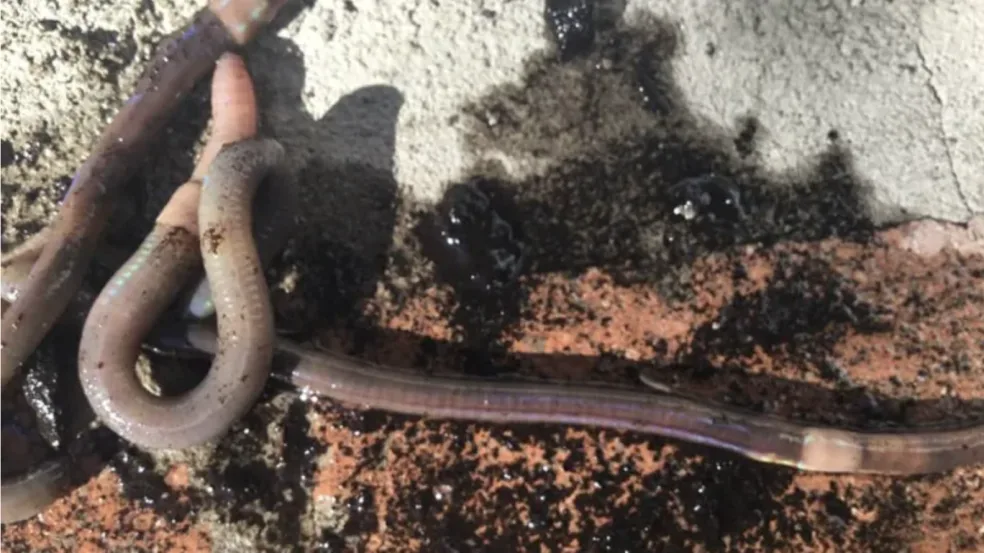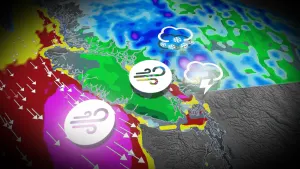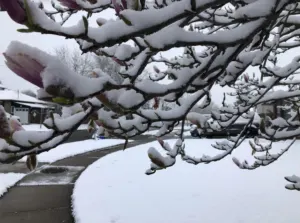
Coming soon to a backyard near you: the invasive Asian jumping worm
Larry Hodgson says if you want to see where the Asian jumping worm gets its name, simply put it in a bowl. Then stand back and watch.
"They'll get out of it," said the Quebec City-based gardening writer, who also goes by the epithet the Laidback Gardner. "These things literally jump. A regular earthworm would have a hard time with that. They just sort of leap and they're quite amazing to watch."
Watching is exactly what Hodgson and the rest of the Canadian gardening world have been doing these past few years as this army of creepy crawlies slowly advances north from Canada's southern border.

These Asian jumping worms, on sun-splashed stone in a backyard in Scarborough in suburban Toronto, were discovered in a contaminated bag of sheep's manure in 2021. (Norma Phillips/Facebook/via CBC News)
RELATED: Planning a spring hike? 5 products to guard against ticks
First discovered in the Windsor area as far back as 2014, the worms were found last summer in other Ontario communities, including Wheatley, St. Catharines, Dundas and the Greater Toronto Area. They've also been discovered in New Brunswick, in the Fredericton-Oromocto area.
How to tell jumping worms from nightcrawlers
"I recorded the first ones and it was a real surprise in 2014," said John Reynolds of Kitchener, Ont.
As a PhD taxonomist, Reynolds is one of the world's foremost experts in earthworms, and has been documenting their arrival in the Great White North since the beginning.
At first glance, the Asian jumping worms look pretty similar to European nightcrawlers, or dew worms, also an invasive species and familiar to most of us.
The way to tell them apart is by their clitellum — the little fleshy band around their body. On a jumping worm, it wraps all the way around and is grey or white; on a dew worm, it's pink and only covers the top, similar to a saddle. The easiest way, however, is to watch them move, according to Reynolds.
"When I first saw them, I thought they were little green snakes until I picked them up," he said. "If you picked one up, you would know."
Worms arrive hidden in soil, usually from the U.S.
Reynolds said the worms typically arrive hidden in soil, either in bags or potted plants, or sometimes in containers of fishing bait imported from the United States.
"They've only been recognized in Canada recently," he said. "We have four species in Ontario and some of the same in New Brunswick."

Asian jumping worms often live in dense populations, just a few centimetres below the surface, leaving behind soil that has been described as having a texture similar to coffee grounds. (Michael McTavish/Invasive Species Centre)
Once they've established themselves, they're difficult, if not impossible, to get them out. Unlike European earthworms, which can live for years, Asian jumping worms live only a single season, hatching, reaching adulthood and dying by the time the ground freezes.
How they survive is the same thing that makes them difficult to remove and easy to spread. Before they die, they leave behind tiny, nearly un-seeable cocoons, which hatch into more worms. Unlike their European cousins, Asian worms are parthenogenetic — a small subset of animals that can have offspring without mating.
Gardeners worried about Asian jumping worms
Asian jumping worms are also voracious, consuming so many nutrients from the first five centimetres of top soil that they can displace other earthworms and reduce the diversity of other soil-dwelling organisms, such as bacteria, fungi, millipedes, salamanders, even some ground-nesting birds – and that's what has gardeners worried about their arrival.
"We're getting reports of problems, the extent of those here in Ontario is not fully understood," said Cathy Kavassalis, an expert gardener in Oakville, Ont., who moderates a social media group on Facebook for the Ontario Master Gardener Program.
Last summer, she started getting photos posted to the group, of strange soil conditions and unusual worms that thrashed when they were disturbed, she said.
"People were a little scared of them. You're digging in the garden, and you get this worm that's kind of bouncing up and squiggling and wiggling.
"They give people the heebie-jeebies."
Debate over how big an issue these worms are
Aside from the creepy factor, Kavassalis said gardeners also reported trouble growing certain plants from seed after the worm arrived because of soil chemistry changes that are still not fully understood.
"The soil starts looking like it's full of coffee grounds. It seems to get coarse and granular. Some people have been reporting problems with watering. Others have said their hostas have been destroyed.
"Again, I don't know what they're going to do," she added. "The reports out of the U.S. say they're extremely disruptive and particularly damaging for top soils."
The ability of the invasive jumping worm to disrupt the soil food web, degrading top soil by rapidly processing leaf litter, might be a cause for anxiety, but it's not fully understood.
Reynolds considers the jumping worm just the latest in dozens of waves of invasive earthworms that have been arriving in North America since Europeans first set foot in the Americas.
WATCH BELOW: MILLIONS OF SQUIRMING MYSTERY WORMS APPEAR ON BEACH—THEN DISAPPEAR
He believes it's too early to tell whether or not the worm is worth worrying about.
"They haven't been here long enough to know and all earthworms are essentially alien anyway," he said, with the exception of half a dozen native species in British Columbia.
"They don't eat the plants. They only eat the decaying material. I'm not on the wagon that it's a big catastrophe or anything like that. Climatic changes are a bigger issue."
This article, written by Colin Butler, was originally published for CBC News.









